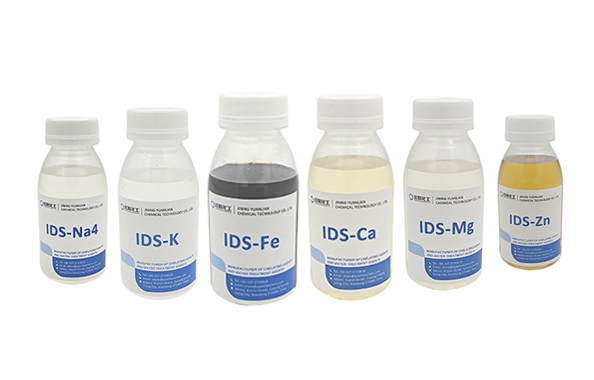
An Overview of Tetrasodium Iminodisuccinate as a Stabiliser for Hydrogen Peroxide
In industrial sectors such as textile bleaching, paper manufacturing, and environmental cleaning, hydrogen peroxide (H₂O₂) is a widely used agent. Valued for its bleaching and disinfectant properties, it decomposes into water and oxygen, presenting a seemingly green profile. However, practical experience reveals a significant challenge: its inherent instability.
1. The Core Issue: Why Hydrogen Peroxide Requires Stabilisation
Rapid and uncontrolled decomposition of hydrogen peroxide is highly problematic. This is primarily triggered by two factors:
1.1. Heavy Metal Ions (e.g., Fe³⁺, Cu²⁺, Mn²⁺)
These ions act as powerful catalysts, drastically accelerating the decomposition of H₂O₂ into water and oxygen, even at trace concentrations.
-
Consequences:
-
Loss of Efficacy: H₂O₂ decomposes before it can perform its intended function.
-
Process Inefficiency: Decomposition is exothermic, leading to uncontrolled temperature and pH swings, resulting in inconsistent product quality.
-
Material Damage: In textiles, aggressive oxidation can damage fibre strength; in pulp and paper, it can degrade fibres.
-
Safety Risks: Rapid oxygen release poses a combustion or explosion hazard in confined spaces.
-
1.2. High Temperature and Alkalinity

The decomposition rate of H₂O₂ increases significantly under high temperature and high pH conditions, which are common in many industrial processes like hot bleaching.
Therefore, the primary function of a stabiliser is to control this decomposition, ensuring H₂O₂ acts in a controlled manner at the desired time and place.
2. The Limitations of Conventional Stabilisers: A Trade-Off
Traditionally, the industry has relied on two main types of stabilisers:
-
2.1. Silicates (e.g., Sodium Silicate): Cost-effective but prone to forming hard, abrasive silicate scales (e.g., magnesium silicate) that clog equipment and are difficult to remove.
-
2.2. Organophosphonates (e.g., EDTA, DTPA): Effective chelating agents, but they pose considerable environmental concerns. They are poorly biodegradable and can persist in the environment, potentially contributing to secondary pollution by remobilising heavy metals.
Given increasingly stringent environmental regulations within the European Union, there is a clear need for high-performance, environmentally sound alternatives. Tetrasodium Iminodisuccinate (IDS-Na₄) emerges as a leading solution.
3. The Sustainable Alternative: Key Advantages of Tetrasodium Iminodisuccinate
IDS-Na₄ is a readily biodegradable chelating agent with a molecular structure designed for high performance and low environmental impact.
3.1. Superior Stabilising Performance: Effective Sequestration
Its molecule contains multiple carboxylate groups that act as powerful chelating sites, effectively binding heavy metal ions like iron and copper. By neutralising these catalytic impurities, IDS-Na₄ significantly enhances the stability of hydrogen peroxide baths under demanding conditions of high temperature and alkalinity.
3.2. Excellent Environmental Profile: Designed for Sustainability
This is the core advantage of IDS-Na₄. In contrast to phosphonates, it is readily biodegradable according to OECD test methods. It breaks down into harmless natural products (water, CO₂, ammonia), presenting no risk of persistence or eco-toxicity, and aligning perfectly with the principles of Green Chemistry and circular economy.
3.3. Anti-Scaling Properties: Preventing Silicate Scale
Unlike silicate-based stabilisers, IDS-Na₄ helps inhibit the formation of hard silicate scales. This prevents deposits on machinery, maintaining heat transfer efficiency and reducing downtime for cleaning and maintenance.
3.4. Broad Compatibility: Suitable for Diverse Applications
IDS-Na₄ maintains its chelating efficacy over a wide range of pH and temperature conditions, making it a versatile and reliable choice for various industrial processes.
4. Summary and Outlook
| Feature | Conventional Stabilisers (Silicates/Phosphonates) | Tetrasodium Iminodisuccinate (IDS-Na₄) |
|---|---|---|
| Stabilising Effect | Good to Moderate | Excellent |
| Environmental Impact | High (Poorly biodegradable) | Very Low (Readily biodegradable) |
| Anti-Scaling | Silicates cause scale | Excellent, prevents scale |
| Life-Cycle Cost | Higher maintenance & potential compliance costs | Improved cost-in-use, longer equipment life |
In conclusion, selecting Tetrasodium Iminodisuccinate as a hydrogen peroxide stabiliser is not merely a chemical choice but a strategic decision towards a more efficient and sustainable industrial process. It successfully balances performance, economic efficiency, and environmental responsibility, representing a forward-thinking solution for modern industry.
For companies committed to process optimisation and sustainable manufacturing, IDS-Na₄ is a compelling option worthy of consideration.
Yuanlian Chemical specializes in the production of polyaspartic acid (PASP),tetrasodium iminodisuccinate(IDS), GLDA, MGDA etc. with stable quality and excellent quantity!





Contact us